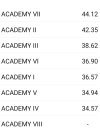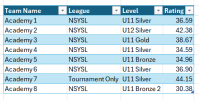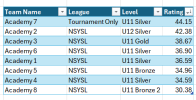Nope. They're handled exactly the same as any other team. Presumably, their competition will be higher so they'll get more value for a given result.How do you handle a team that plays a year up in the tournament? Do they get bonus points for beating a one year older team?
You are using an out of date browser. It may not display this or other websites correctly.
You should upgrade or use an alternative browser.
You should upgrade or use an alternative browser.
Youth Soccer Rankings ?
- Thread starter dawson
- Start date
We've covered this before. LAFC is the example I'm most familiar with. They will often play entire teams or even all the teams on a given matchday up against weaker clubs to make the games more competitive. This will skew the results.So which MLS Next team has incorrect ratings due to this? We can all look at them together and confirm one way or the other.
RandomSoccerFan
PREMIER
I think you're probably right, but it doesn't matter much from a ratings/ranking standpoint. They are still the #6 in the country (3rd highest in MLS N) out of over 3,000 teams. The spreadsheet shows that they vary somewhat more than anyone else in the top 10 for MLS N- but anyone who expects them to vary so widely that it will be an easy game is just kidding themselves. The Strikers have a similar profile.
RandomSoccerFan
PREMIER
Yep, that's fair. Just this MLS Next season alone - Strikers has 5 underperforms and 2 overperforms, so their rating is on a somewhat downward trend. For LAFC - they are looking at 4 overperforms and 2 underperforms against the calculated rating. Yes - they might swap some or all of the roster entirely to make up a team - but the rating for the team entity as a whole isn't far off, and is slightly improving. Would be interesting to match up the overperform/underperform games with the specific roster for those games, to see if there really is any alignment.
Except that they did the same last year, so we're comparing their hybrid teams year over year.For LAFC - they are looking at 4 overperforms and 2 underperforms against the calculated rating. Yes - they might swap some or all of the roster entirely to make up a team - but the rating for the team entity as a whole isn't far off, and is slightly improving.
Yeah, you'd have to do something like that, but then you'd have to know which roster they're bringing to a specific game to predict results.Would be interesting to match up the overperform/underperform games with the specific roster for those games, to see if there really is any alignment.
Of course, as soon as you do something like this, you could apply it to all the teams and then see which rosters / individual players lead to which results. I don't think we want that...
RandomSoccerFan
PREMIER
I think there may be too much emphasis on which kids were actually on the field, compared to a team's rating. For the former - of course it matters for a variety of reasons. For the latter - it turns out to matter very little in aggregate. The ratings are useful for a team to measure themselves, and for an opposing team to understand the strength of who they are meeting on the pitch. It turns out that even in the case of LAFC - the rating is quite predictive, and their ranking is where it should be - even if someone knows that the actual kids might be a year down, might be actual year, or might be a hybrid of sorts.
RandomSoccerFan
PREMIER
There was apparently an outage/glitch with some of the data in SR as of last Friday. Much of it is recovered, and over time it will likely get back to right where it should be - but if a team you're following doesn't show the current year's schedule or is missing other games, and you can't find the games in the db to re-add them, send them a message and they will confirm and fix as needed. All of NorCal RL this season was one of those uploads that was lost, but as of today all should be back to normal; NL didn't seem to have issues. SoCal RL and NL both seem OK as far as I can tell, but I only spot-checked a few teams.
RandomSoccerFan
PREMIER
There's something that feels right (and satisfies any OCD tendencies), when a club sets up their teams ranked 1 through 5 or whatever for a certain age, and then the performance of the kids they placed and then developed on each team matches that ranking, so when looking at the club they are in number order in SR, with each team slightly stronger than the one rated lower, all named in order. It happens reasonably often, so coaches/docs do a pretty good job of assessing individuals and teams, and the team performance generally confirms that. But then there are other cases, where it looks like they threw a dart at the players and put them on a random team name, where the rankings/ratings make no sense at all. Take a look at this case, where there are 8 teams at this 2013 age group, and team number 7 is at the top, while team number 1 is near the bottom, and would be expected to lose to team number 7 by over 7 goals. One interpretation could be that obsessing over being on the "right" team at this young age doesn't matter much, and playtime/development is most important wherever. A more cynical interpretation is that this club isn't particularly good at assessing younger potential talent.


There's something that feels right (and satisfies any OCD tendencies), when a club sets up their teams ranked 1 through 5 or whatever for a certain age, and then the performance of the kids they placed and then developed on each team matches that ranking, so when looking at the club they are in number order in SR, with each team slightly stronger than the one rated lower, all named in order. It happens reasonably often, so coaches/docs do a pretty good job of assessing individuals and teams, and the team performance generally confirms that. But then there are other cases, where it looks like they threw a dart at the players and put them on a random team name, where the rankings/ratings make no sense at all. Take a look at this case, where there are 8 teams at this 2013 age group, and team number 7 is at the top, while team number 1 is near the bottom, and would be expected to lose to team number 7 by over 7 goals. One interpretation could be that obsessing over being on the "right" team at this young age doesn't matter much, and playtime/development is most important wherever. A more cynical interpretation is that this club isn't particularly good at assessing younger potential talent.
View attachment 21048
I literally just went through this exercise of looking at how to use SR rankings as a tool to gauge age group health for a given club. SR should considering making this a premium service. Essentially I created a spreadsheet with each team's ranking for each age group. I summed the deltas and normalized the numbers based on the total number of teams in the ranking selection per age group I think this could give a club a perspective into the health of their placements and perhaps identify some opportunities. This wouldn't cover the edge cases, but could definitely signal where there's an issue. I think more could be added by looking at schedule strength as well. I think this is a great way to use the data in SR without getting so hung up the rankings themselves.
RandomSoccerFan
PREMIER
Yep, I think it's silly for someone running a club to have access to this data and not choose to use it to both confirm previous choices, and make the same or different choices going forward to better meet whatever goals they have for the teams & age group.
I think Mark's decision to rank clubs against each other by only looking at the top team per age group, is probably the best way to display the strongest club. It doesn't matter if the club has 2 teams of that age group or 30 teams- how strong is the top one and would it be expected to beat the top team of the competing club. It probably is the best way to measure "which club has the strongest teams", and from that viewpoint it is probably the best way to rank clubs. But just having the 1 top team per age group isn't the goal of many clubs; I'd instead guess that it is the goal of a pretty small minority of clubs. Instead - their goal is to have plenty of teams of each age group to match whatever resources they have available and can provide. Setting the teams up properly initially and adjusting them over time seems to be a pretty important part of club management.
I think Mark's decision to rank clubs against each other by only looking at the top team per age group, is probably the best way to display the strongest club. It doesn't matter if the club has 2 teams of that age group or 30 teams- how strong is the top one and would it be expected to beat the top team of the competing club. It probably is the best way to measure "which club has the strongest teams", and from that viewpoint it is probably the best way to rank clubs. But just having the 1 top team per age group isn't the goal of many clubs; I'd instead guess that it is the goal of a pretty small minority of clubs. Instead - their goal is to have plenty of teams of each age group to match whatever resources they have available and can provide. Setting the teams up properly initially and adjusting them over time seems to be a pretty important part of club management.
RandomSoccerFan
PREMIER
I think more could be added by looking at schedule strength as well.
I think showing schedule strength is a brilliant addition to SR, and provides an objective answer to the questions that are often brought up about what type of competition a team is really seeing. A team playing a stronger schedule vs. a team playing a weaker schedule really shows what they faced that season, and what their results represent.
But we need to be careful to not overemphasize that data as a new piece of information that would affect the rating itself - because it doesn't. It is just the average rating of the teams that the selected team saw, that's it. In other words, a team that is rated 45, but saw a schedule ranked 47, played harder teams than themselves - and they'd be expected to have a losing record. A separate team that is also rated 45, but saw a schedule ranked 43, played weaker teams than themselves, and they'd be expected to have a winning record. But if those 2 teams ranked 45 played each other - neither would have an advantage, and their projected score would be a tie. The 45 with the hard schedule isn't expected to beat the 45 with the weaker schedule, or vice-versa - their inherent rating is what it is. And it likely would be a pretty good game.
At larger clubs with multiple teams in an age group, there's a lot more going on than just selecting the 1st, 2nd and so on teams. It's not like they have a single pool of kids and divvy them out. Geography plays a part (especially at the younger ages) and there are many cases where teams jump clubs, or clubs merge. When clubs merge, the relative rankings are often way off for a while because someone has to get the top slot and no one wants to reshuffle all the teams at once. Over time, this may balance out, but it's not like the club is working from a single pool of kids and ordering them.But then there are other cases, where it looks like they threw a dart at the players and put them on a random team name, where the rankings/ratings make no sense at all.
RandomSoccerFan
PREMIER
All true - but if you're in a situation where the team that is named the number one team is actually the 5th strongest team in that age, and the number 7 team is actually the first team, it's more than just a geography problem or a club merger issue. Because at the heart of it, the parents (customers) of the club believe their kid is on the X team, and that has value to them, especially as the teams get closer to the pointy end. If it may as well be a random number, it isn't quite as valuable a concept as if the team names and levels actually meant that the club at least attempted to rate them during tryouts or other assessments.
This is also why so many clubs use arbitrary colors. Everyone knows gold is better than black (or whatever), but no one writes it down anywhere so everyone feels like maybe they're the best.All true - but if you're in a situation where the team that is named the number one team is actually the 5th strongest team in that age, and the number 7 team is actually the first team, it's more than just a geography problem or a club merger issue. Because at the heart of it, the parents (customers) of the club believe their kid is on the X team, and that has value to them, especially as the teams get closer to the pointy end. If it may as well be a random number, it isn't quite as valuable a concept as if the team names and levels actually meant that the club at least attempted to rate them during tryouts or other assessments.
rainbow_unicorn
PREMIER
Something is obviously wrong with this particular example. Maybe the team game results are getting mixed up with each other since they have so many damn teams in the same age group. Which state/club is this academy?
I agree. It's actually pretty easy to gauge talent sufficiently enough so that a result like this example would never happen. Yes, it's tough to gauge talent at the margins (10th best player versus 11th best player - usually a tough call) but you would never goof things up so bad that it looks random like this grouping.Something is obviously wrong with this particular example. Maybe the team game results are getting mixed up with each other since they have so many damn teams in the same age group. Which state/club is this academy?
RandomSoccerFan
PREMIER
Something is obviously wrong with this particular example. Maybe the team game results are getting mixed up with each other since they have so many damn teams in the same age group. Which state/club is this academy?
I agree. It's actually pretty easy to gauge talent sufficiently enough so that a result like this example would never happen. Yes, it's tough to gauge talent at the margins (10th best player versus 11th best player - usually a tough call) but you would never goof things up so bad that it looks random like this grouping.
Nope - I thought the same thing, and then looked at the game sources directly. These teams are all correct - and they are incredibly easy to sort out, as they are all named Academy 1, Academy 2, etc. All game sources say nothing but the exact same name of the team. It isn't a case of wrong data being assigned - unless they are registering in tournament and leagues under random names as well. Check out the club's 2013B teams, it rhymes with Malbion Vas Legas. It's also the #1 ranked boys club and both club in that state.
rainbow_unicorn
PREMIER
Or maybe the I, II, III, IV, etc. designations are purely random numbers assigned to these teams and are not an indicator of what level they are. Maybe @VegasParent or @LVB have some Vegas insight here on Albion 2013 boys teams.
RandomSoccerFan
PREMIER
Beats me. Your guess is as good as mine. But all but one play in the exact same league, and Academy 7 (the top one), only plays tournaments, but joins the same age/level in the most recent tournaments as several of the other teams. Here's one view sorted by team name, and another sorted by rating, which also displays the league level. It still doesn't show a rationale or a reason for it being this way - and it still just looks incredibly random.




RandomSoccerFan
PREMIER
Players statistics launched today. Should be interesting to see how it plays out - will see over the next season or two whether people find it useful or not.


